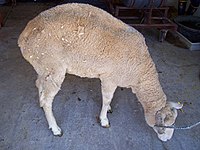
Photo from wikipedia
Scrapie in goats has been known since 1942, the archetype of prion diseases in which only prion protein (PrP) in misfolded state (PrPSc) acts as infectious agent with fatal consequence.… Click to show full abstract
Scrapie in goats has been known since 1942, the archetype of prion diseases in which only prion protein (PrP) in misfolded state (PrPSc) acts as infectious agent with fatal consequence. Emergence of bovine spongiform encephalopathy (BSE) with its zoonotic behaviour and detection in goats enhanced fears that its source was located in small ruminants. However, in goats knowledge on prion strain typing is limited. A European-wide study is presented concerning the biochemical phenotypes of the protease resistant fraction of PrPSc (PrPres) in over thirty brain isolates from transmissible spongiform encephalopathy (TSE) affected goats collected in seven countries. Three different scrapie forms were found: classical scrapie (CS), Nor98/atypical scrapie and one case of CH1641 scrapie. In addition, CS was found in two variants—CS-1 and CS-2 (mainly Italy)—which differed in proteolytic resistance of the PrPresN-terminus. Suitable PrPres markers for discriminating CH1641 from BSE (C-type) appeared to be glycoprofile pattern, presence of two triplets instead of one, and structural (in)stability of its core amino acid region. None of the samples exhibited BSE like features. BSE and these four scrapie types, of which CS-2 is new, can be recognized in goats with combinations of a set of nine biochemical parameters.
Journal Title: Veterinary Research
Year Published: 2019
Link to full text (if available)
Share on Social Media: Sign Up to like & get
recommendations!